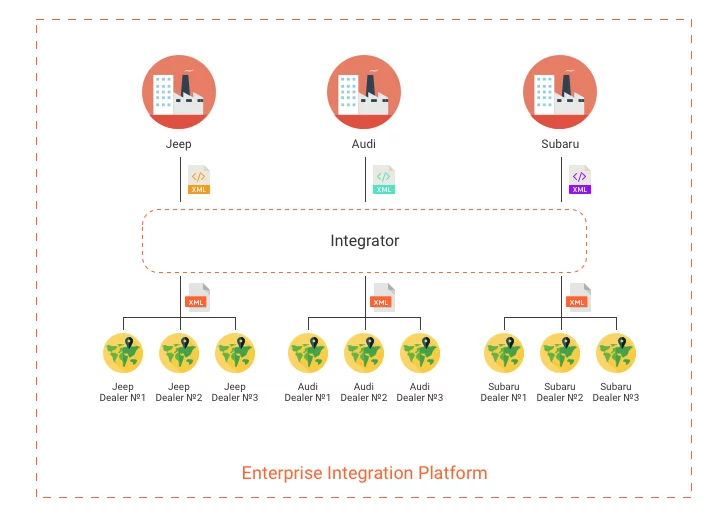How to Develop an Unparalleled Liferay Portal for Automotive Dealers and Manufacturers?

Communication in the meaning of a process by which information is exchanged between two objects (individuals or systems) has a certain air of importance in business. One case when it comes to sharing information between people within a company aimed to get a commercial benefit of the organization and to promote products or services to potential clients. Another case is an error-free communication between software which is different.
‘Don`t communicate to be understood; rather, communicate so as not to be misunderstood.’ A quote attributed to Dr. John Lund explains in the best possible way any business communication within an enterprise or beyond it. Here we are going to narrate about the enterprise integration platform (hereinafter EIP) and how to build an unparalleled portal for interchanging information where an error troubleshooting in third-party integrations ranks number one.
As an example, we will discuss a functioning EIP which is used to coordinate manufacturers and dealers moving their interaction up at the highest level.
Multi-trillion dollar industry
The disruptive blockchain burst in on almost all major operation spheres of social life among which finance, energy, trade, media, government. As a consequence, it has reached a multi-trillion dollar industry thriving to revolutionize automotive.
However, there are many urgent challenges for industry specialists in their daily operation. Global sales of passenger cars have reached the 79 million vehicles for now. Figures are impressive. The coordination of cars and OEM parts distribution worldwide demands a considerable digital succor.
The aim of this article is to guide you through the possibilities of your business’ healthy and vigorous growth by the moderate open-source platform Liferay serving for enterprise purposes.
Liferay Portal: building an ecosystem for bilateral communication
Today it is more than possible to make an ecosystem which would meet manufacturers and dealers, keep relevant content and strong role differentiation. It combines information from different sources into a single user interface.
Liferay holds a central place here underlying the corporate portal. It fits perfectly because it contains a single point with portal-like systems which enterprises use to operate their daily activities:
- local news portal;
- wiki pages with specifications;
- media gallery, document library (cloud box);
- online user and role management;
- and others.
A while back we wrote about the personal account and company-wide features of intranet listing features of it.
A multi-tenancy support of Liferay opens the opportunities of creating and managing more than 200 of websites on the active portal within a single installation, organizing and managing the information, roles, permissions, etc. An umbrella organization allows coordinating activities, sharing awareness-raising content (articles, wikis, portlets, etc.), and providing an arrangement for the affiliated sites under its appropriate care. This makes possible for car manufacturers to create separate websites for dealers and manage them independently in accordance with their needs.
There are two types to create sites in Liferay: communities and organizations. Each of them may have its own characteristics in order fully to achieve the objectives.
Liferay Communities proved useful for covering needs in having a custom website with pages, content, and apps being accessed by a group of people (department employees) or single users (supervisors). It is successfully realized in building websites for dealers in the portal in one click. Custom functionality continues to be enhanced as far as new dealers join the data integration system.
Liferay Organizations are perfect matching for organizing users and delegating their administration inside the portal. It helps there to assign roles hierarchically so important for corporate portals like described with millions of users.
Read also: Our Vision for Corporate Portal DevelopmentLiferay Integrator: error-free data transferring
The system represents two component parts of a single whole: umbrella-like Portal and Integrator. Let us elaborate on the latter.
Integrator is a platform for dealer systems integration which allows manufacturers to determine requirements to the data structure and dealers to adjust their systems accordingly to these rules.
Let’s consider a typical situation. A manager of car manufacture plant wants to transfer the updated catalog of spare parts to the car dealer. He wants to be sure that data won’t be scrambled, it is expected to be transferred failure-free and be recognized without errors. Taking into account the fact that information is processed in average 1 time per day the cost of failure increases many times. To prevent the failure, it is used a validation system of incoming and outcoming files named Certification Testing.
To provide the validation of files, it is used a special XML Builder, an embedded software module which allows users (manufacturers) to determine specific requirements for the data structure needed to interact with their system. XML Builder determines a file format of data and parameters for verification.
On the website connected to Integrator, any manufacturer/dealer uploads sales reports for a 2Q period of the current year on Ford, Volkswagen, BMW brands. Before entering the data he/she can verify the data. If they contain a failure, Integrator not only notifies but determines the failure. In the large 40kb file Integrator indicates a missed attribute and how to correct it. Uploading the file into the Integrator it takes a day while the system updates all data.
How it works and how it profits
There could be a lot of different dealers partnering with a plant. So the information management system has to be adjusted to each of dealer’s following its rules. Every company, plant, or reseller has its own custom developed system of document standards.
Integrator makes test cases automated generating an immediate pass/fail response so needed for developers of both manufacturer and dealer DMS (Dealership Management System) systems. During the certification process files are verified by criteria of validity and rollout times are decreased. Also, Integrator simplifies the integration of data into the manufacturer’s database. It converts files of different structures and shows adapted versions of them to the retailer and manufacturer accordingly with further transferring to the particular systems. If it is no integration solution, then documents have to be adjusted manually with staffed people. But in the case of what is stated, there is no longer any need of it.
If it is expected to proceed with enhancements after releasing the rollout in the coming years, then an operative implementation and the verification of data in DMS systems will be of chief priority.
Data collected in real time can be leveraged by the manufacturer at the spot. For instance, it may be transferring a final purchase order from the successful dealer when a ‘Deal of the Century’ is at stake. Every minute counts.
It is designed to provide a strong actual experience analytics for manufacturers instead of inaccurate conventional forecasting full of probabilities. Dealers get, in their turn, improved customer experience happen to be across touch points of the buyer’s journey.
Integrator caused decreasing of time for countless files, testing and certification to be evaluated. Hereby, it settles the chief problem of all third-party integrations called an error troubleshooting. It’s no small feat.
An alternative conclusion
Business is greatly impacted by the way of enhanced technological infrastructure to support the favorable conditions of the ecosystem.
We tried to be clear and concise. Umbrella-like Portal and Integrator became a trend-setter both within the automotive industry and beyond it. Their union solved a vital problem of communication between separate software systems. Liferay teamed up manufacturers and distributors providing full-fledged portals with the necessary set of features for each, distributed inner documentation for sharing among users, and structured the data, websites hierarchically within one integration system.
The Liferay platform is excellent for companies requiring a ready-for-use infrastructure which can be easily adjusted to the conversion of data and gather all under one roof.







